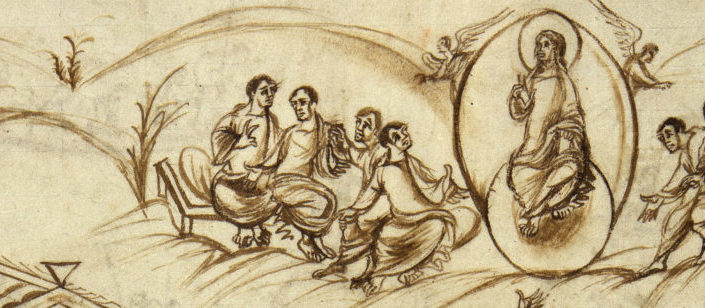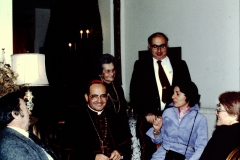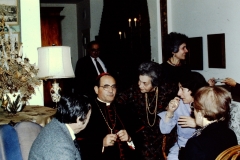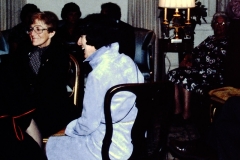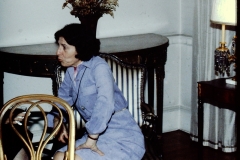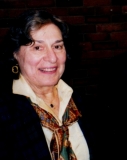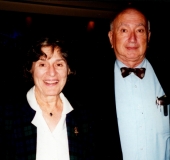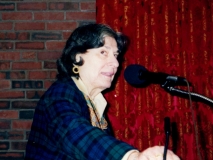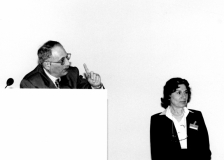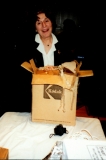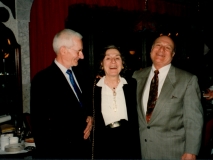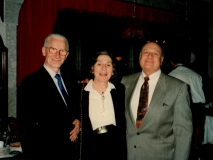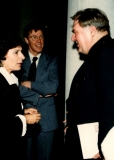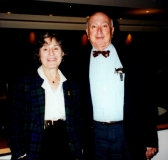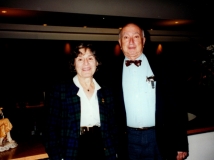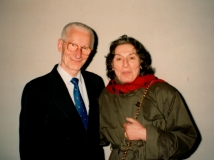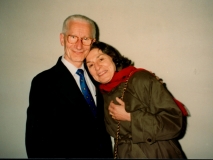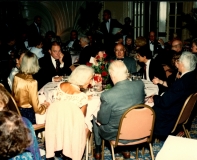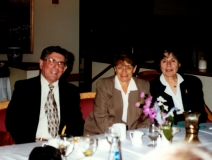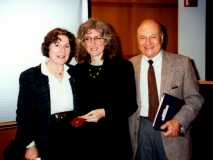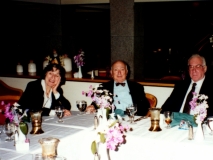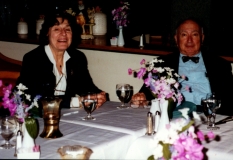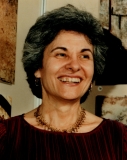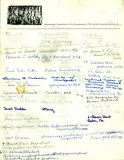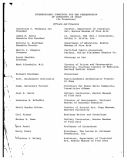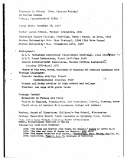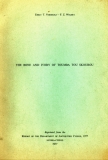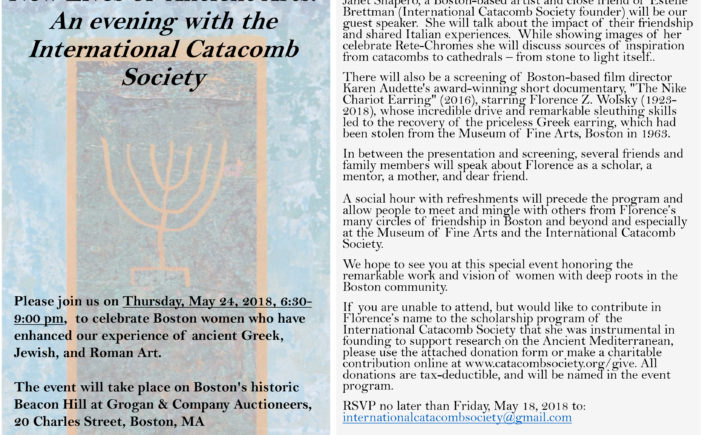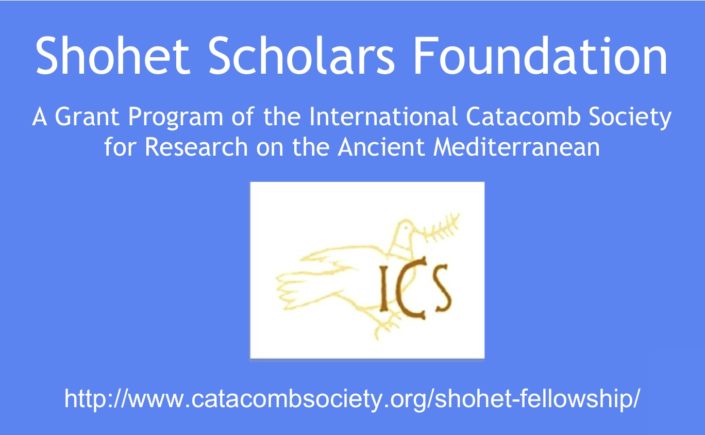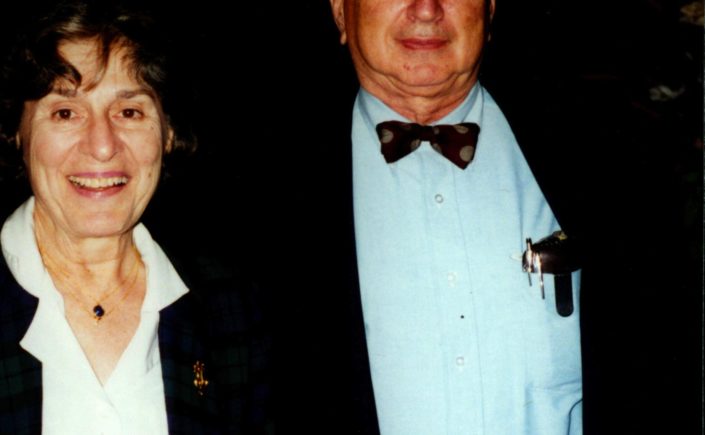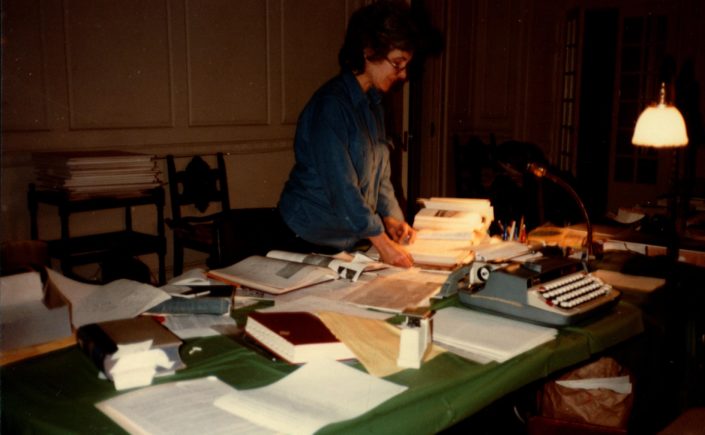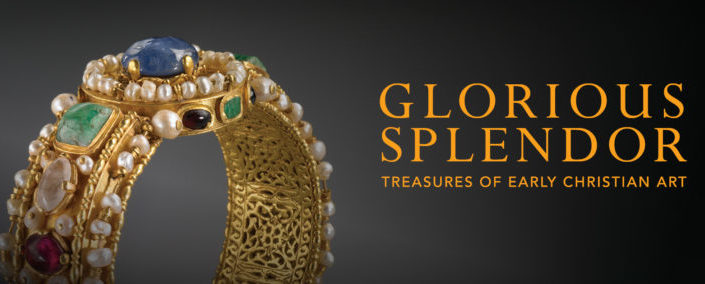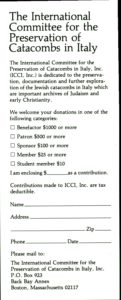 On May 24, 2018, International Catacomb Society members and friends came together on the premises of Grogan and Company on Charles Street in Boston to honor two of the organization's founders and longtime directors, Estelle S. Brettman and Florence Z. Wolsky. The joint commemoration was made to celebrate the deep friendship between the two and shared interest in the Classical world, which led to collaboration on exhibits and events for the Museum of Fine Arts and Boston Society of the Archaeological Institute of America before the birth of a new non-profit foundation in 1980 to promote research on Jews in the Greco-Roman world. This new entity, the International Catacomb Society (ICS), originally the International Committee for the Conservation of Catacombs in Italy (ICCI), in time widened the scope of its mission, but never lost the dedicated, focused presence of these two women, who believed in the visionary enterprise not only at its start, but as long as they were able, Wolsky even retiring from the MFA's Classical Arts department to take over the public operations of the ICS after Brettman's death in June of 1991, and remaining on the board until her own death in 2018, just as her final, posthumous collaboration with Brettman, the catacomb study, "Vaults of Memory: The Roman Jewish Catacombs in Context in the Ancient Mediterranean World," was being released in digital form. The May 24 event was, in fact, one of the very few to date at which Wolsky was lacking, though her presence was as strong as ever, thanks to the showing of a documentary by artist Karen Audette, "The Nike Chariot Earring" (2015), narrating Wolsky's involvement in the recovery of a priceless artifact in the MFA's collection, and personal tributes to her spirit and character movingly delivered by her son, Alfred Wolsky, current president of ICS, and John J. Herrmann, Jr, Wolsky's longtime colleague and supervisor at the MFA from 1976-2004. The Audettes have graciously given ICS permission to share the film here (link).
On May 24, 2018, International Catacomb Society members and friends came together on the premises of Grogan and Company on Charles Street in Boston to honor two of the organization's founders and longtime directors, Estelle S. Brettman and Florence Z. Wolsky. The joint commemoration was made to celebrate the deep friendship between the two and shared interest in the Classical world, which led to collaboration on exhibits and events for the Museum of Fine Arts and Boston Society of the Archaeological Institute of America before the birth of a new non-profit foundation in 1980 to promote research on Jews in the Greco-Roman world. This new entity, the International Catacomb Society (ICS), originally the International Committee for the Conservation of Catacombs in Italy (ICCI), in time widened the scope of its mission, but never lost the dedicated, focused presence of these two women, who believed in the visionary enterprise not only at its start, but as long as they were able, Wolsky even retiring from the MFA's Classical Arts department to take over the public operations of the ICS after Brettman's death in June of 1991, and remaining on the board until her own death in 2018, just as her final, posthumous collaboration with Brettman, the catacomb study, "Vaults of Memory: The Roman Jewish Catacombs in Context in the Ancient Mediterranean World," was being released in digital form. The May 24 event was, in fact, one of the very few to date at which Wolsky was lacking, though her presence was as strong as ever, thanks to the showing of a documentary by artist Karen Audette, "The Nike Chariot Earring" (2015), narrating Wolsky's involvement in the recovery of a priceless artifact in the MFA's collection, and personal tributes to her spirit and character movingly delivered by her son, Alfred Wolsky, current president of ICS, and John J. Herrmann, Jr, Wolsky's longtime colleague and supervisor at the MFA from 1976-2004. The Audettes have graciously given ICS permission to share the film here (link).
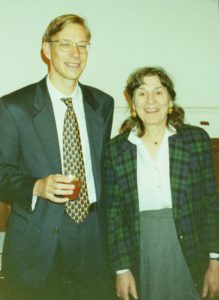
Florence Wolsky with Prof. Leonard V. Rutgers at ICS event in 1997
In addition to the presentations, the evening was made especially pleasurable by the generous hospitality of the Grogan family; the delicious Mediterranean refreshments from Boston Kebab House provided by ICS financial advisor David Basile; an abundant displays of flowers from ICS president Alfred Wolsky, son of one of the honorees; and donations to the Shohet Scholars Fund by many ICS supporters and friends. Their kindness helped make this event not one of nostalgia for the past, but hope for the future of ICS.
From Stone to Light with Janet Shapero
Of Estelle Brettman, much has been said and recorded on the ICS website, including an eulogy by Wolsky at an early tribute held in 1992. "New Lives of Ancient Arts," however, brought a new voice into the act, that of artist Janet Shapero, who as a young girl developed a special bond with Brettman during a trip to Sicily in the mid-1970's, an experience which Brettman later said was the impetus for her creation of the ICS. The "lightning-flash" moment, as recounted by Shapero, happened during a visit to the necropolis of Palazzolo Acreide in Eastern Sicily. Close to the entrance to one of the burial caves cut into the hillside, one of the women hit her foot against a small boulder and dislodged it. Rolled over, it revealed a scratched design that resembled a straight-branched candlestick, similar to some ancient depictions of the Jewish ritual object known as the menorah. An extra detail that Shapero added to the story during her May 24 lecture is that right before the Sicily trip, she and the Brettmans had seen the exhibit "Age of Spirituality: Late Antique and Early Christian Art, Third to Seventh Century" at the Metropolitan Museum of Art, which featured several artifacts with Jewish emblems or other documentation that linked the material to a Jewish context. The show's ground-breaking approach for the time was to look back at the Late Roman era not as a period of decadence and destruction but as an Empire-wide passage to Christian rulership under many ancient norms. Brettman and Shapero were thus "primed" to consider Jewish artifacts in mixed settings, as the burial grounds had been used over many centuries for pagans, Christians, and, apparently, also by Jews.
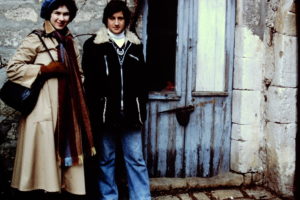
Janet Shapero at Palazzolo Acreide, Sicily.
Shapero also recalled Brettman's faith in visionary thinking and individual goals, those seemingly impossible but important to achieve for the soul's sake, beyond any promise of material rewards. With evident gratitude, she described how Brettman had helped her through the early stages of her career as a multimedia artist in sculpture and film to get out of dead ends and take risks with her work. Later, in her exploration of the effects of light and color layering in her signature "Rete-Chrome" series, Shapero thought back to Brettman's interest in ancient Jewish motifs, and integrated a variation on the menorah they had found in the piece "Menorah-In Memory of Estelle" (2013), and the Hebrew letter "Shin" in another (2012). In this way, she felt connected to Brettman once again over the use of art to express one's own inclusion in the whole, "owning what is my own, my Jewish experience," as she put it.
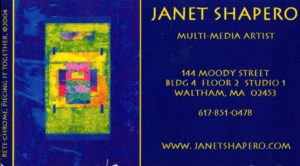 In her talk, Shapero also elaborated upon her artistic development with memories of her apprenticeship to a public sculptor in Italy and realization of installations in sites throughout the United States and abroad. She works today in a studio near Boston, which can be visited upon request and on occasion holds "open studios". A digital catalogue of her work is on view at janetshapero.com.
In her talk, Shapero also elaborated upon her artistic development with memories of her apprenticeship to a public sculptor in Italy and realization of installations in sites throughout the United States and abroad. She works today in a studio near Boston, which can be visited upon request and on occasion holds "open studios". A digital catalogue of her work is on view at janetshapero.com.
The second part of the evening was a very personal and immediate commemoration of Florence Wolsky, who died this past winter at the age of 95. In addition to the film showing and remarks by MFA curator emeritus, John J. Herrmann, Jr., on Wolsky's resolve of the Nike Earring Caper, a vivid sense of Wolsky's personality was evoked by her son, ICS President, Alfred Wolsky, who described his mother as a formidable scholar, writer, artist, and matriarch. It was impossible not to imagine Wolsky in the room, sitting near the front, listening with pleasure and pride to her son's lively but also deeply heartfelt narrative of her achievements and character. With permission, Alfred Wolsky's talk is reproduced below.
Florence Wolsky: Wife, Mother, Scholar, Artist: Tribute by Alfred Wolsky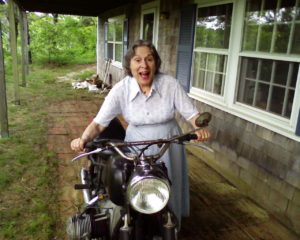
"I thought originally that it would be easy for me to write and say a few words about my extraordinary mother, Florence Wolsky. After all, I thought, there are so many things to talk about.
But it has proven difficult for me, very difficult; and for the exact same reason. There are so many things to talk about.
She had a distinguished and successful life by any standard, jammed, it seems in hindsight, into a mere 95 years: a life made all the richer both for herself and for the many many people who knew her - and loved her; by the wonderful animus, energy, kindness, and remarkable initiative she brought to living it.
She was born in the last days of 1922 in Fall River. Her father, Max Zundell (Zundell is an Ellis Island pronouncement "Sonny boy" given to his father, Isaac Juvantischi). Max, born in the US in July of 1884, was a professional and talented violinist, and I am certain that Florence inherited her considerable musical talents and artistic temperament from him. Her mother, Helen, was a dressmaker who had immigrated to the United States in 1913 to avoid the pogroms in Eastern Europe. She was an unassuming, very smart lady who, when I came onto the scene many years later, was fluent in at least 5 languages: Russian, Yiddish, Polish, German and English*. (*My mother was also a champion speller, and could complete Henry Hook crosswords in the Globe -no matter how unreasonable the clues were- almost always without any assistance). Helen & Max were caring, dedicated, loving parents to my mother, and I knew them as kind, extremely gentle and loving grandparents. My mother certainly inherited these qualities and did her best to pass them on to my sister, Liza, and to me.
After some moving around during the Depression years which hit her and her family very hard, indeed, Florence finished her high school at Girls' Latin School in Boston and then studied at Cambridge Junior College, where she made lasting friendships which endured and guided her as long as life allowed; and perhaps beyond that, depending upon perspectives...
She met my Father, Leonard Wolsky, during the war, probably during the period she worked as a drafts-person at MIT on the first digital computer prototype, WHIRLWIND 1 -as her contribution to the war effort. During their courtship, she told me, she would go on walking dates with Lenny, because neither of them had any money, and Florence had no problem going out for a date on the super cheap!
They were married in 1944. I must say a few words about my Father, and it is no digression, because my parents were happily and inseparably married for more than 50 years until he passed away in 1996. In many ways they were, or over time, became- serious reflections of each other's backgrounds and leanings; so that in commenting on the one, the other had to be included for clarification or essential reference! Leonard had gone to Boston Latin School and hated it, but graduated first in his class of 1940; he then attended Harvard on a full scholarship, and, in his junior year was first in his class at the College, but never graduated (his was the Class of '44). He proceeded, instead - under wartime considerations - with a full scholarship to the Medical School from his junior year. My Mother complained - if that is the word to use - self-deprecatingly, that after my father met her, he stopped studying, took her out for dates on nights preceding exams--- and only graduated 5th in his medical school class. She also would state - a little wistfully - that she might have had a professional career in music had she not married him and settled down…and had children…. She was an accomplished singer and skilled performer on piano, zither and guitar, and wrote numerous funny songs, skits and even a whole kosherized spoof on Madama Butterfly (Butterfly Finklestein, Queen of the Ginza, I dip all mein bagels in Sake). She even snuck into the back stage of the Boston Opera, one evening, threw on a costume and majestically waved a huge fan in the AIDA Triumphal scene! For those who knew her, close your eyes: can't you just see it?
My Father, Dr. Wolsky, was, first and foremost and by his personal mission statement, a healer -but, in addition, he was a self-disciplined and accomplished scholar. To give just one example, he was asked to deliver a series of lectures on biblical history to students at Regis College, a Roman Catholic institution - very well received by students and faculty alike! - this certainly encouraged Florence's aspirations to study the subjects which interested her, and during the early 60's she returned to college, studying at Boston University and eventually obtaining a masters degree. It was there, as a mature undergraduate, that she became acquainted with Emily Vermuele, first as her professor, and later (after she recovered the Nike Earring for the MFA)--more about that later- as a mentor and friend; all leading to Florence's 40+ year stint (overall) in the Classical Department (later Arts of the Ancient World) at the MFA.
And as it may be said, whilst all this was going on, Florence also maintained her active interest in music by becoming the assistant director (working with her close friend Anita Kurland) of the Youth Concerts at Symphony Hall program, and she was an expert on the concert hall itself (I became and expert in making paper airplanes form the program brochures at concerts), and on the somewhat risqué (for Boston) statuary adorning the place, giving talks on the subject, and publishing articles which I understand are still quoted in Symphony Hall program pamphlets!
She was active in the Isabella Stuart Gardner Museum, giving gallery talks, and she composed The Isabella Gardner Rag ("though she really was a bossy old bag!"); a song which will live forever, I am certain, among the cognoscenti…
And, she became a close friend of Estelle Brettman, the founder of the ICS, and, as the original Secretary of the new organization, was one of the principals involved in setting up the outfit and in carrying on Ms. Brettman's original research and vision which, as you can all attest, right now, is a legacy in progress!
Of course, my interface with Florence was as my mother. I forgive her for trying to educate me (as should those of you who know me). After all, she tried very hard. If you agree with that astute sage -whose name I can't recall just now- that education is what remains after one has forgotten everything he was able to learn in school then maybe her efforts were not in vain...
Florence Wolsky was one of the kindest, most compassionate, diplomatic, polite, tolerant and generous people who ever lived; except that she was much tougher with herself and her children, upon whom she attempted to impose her standards---which were exceedingly high- to be honest, at the level of absolute perfection! These standards, however, led to her painstaking thoroughness and undeniable attainment of excellence in her career of scholarship and research at the MFA (and in the ICS); leading her to be published and co-cast as an author with Professor Emily Vermuele of that WEIGHTY bestseller, Toumba Tou Skouru , and to be of vital assistance in many MFA departmental projects such as: the Pompeii AD 79 show; the Romans & Barbarians exhibition; The Search for Alexander; and numerous gallery talks over the years.
She had scores of friends - many close friends - and admirers. Her social calendar was jammed! My mother smuggled me into lectures, semi-private receptions at the MFA- and elsewhere; and I met many people through her good offices who inspired me and enriched my life. To name a random few of the many: I became well acquainted with the Vermueles; Cornelius and Emily, met Zahi Hawas, Mme. Deroches Noblecourt, Mark Lehner, Peter Lacovara, Lawrence Berman, Tim Kendall, John Herrmann and Annewies (whom I am still on speaking terms with); Jessica Dello Russo… even Malcolm Rogers---and one Sunday afternoon I almost knocked over, by mistake, Michael Dukakis at one of the gallery exhibitions (we both apologized); I listened to ancient musical instruments from the Museum Collection, visited the basement "exhibits" -some of the best stuff there… and got to know many of the guards and other folks whose lives revolved around the place.
There were many unique and unforgettable memories, but my favorite one (and you will please forgive me for relating an anecdote) is when we took Prince Ank-Haf home.
You must understand that my Mum was close friends with everyone at MFA. Everybody. I wonder if one minor reason was that she, out of genuine solicitude for all her many, many personal friends - kept her purse full of dark chocolate - especially almond mini Hershey bars, which she freely gave out to everyone whether they needed a chocolate fix or not. Florence's attitude was that they always did. Chocolate- particularly the dark, concentrated kind- was a mood elevator, she said, and had anti-oxidants in it ….among other ingredients…. It is not that far-fetched of a concept to consider that the whole ambience - mood if you will - of the MFA may have been influenced - elevated - to some small degree - by my mother's daily and widespread circulation of these beneficent and healthful treats to curators, staff, guards, security, maintenance people, administration - bewildered visitors - in fact, everybody.
Anyway, Florence was able to arrange with the Egyptian Department to - if the word is right - de-accession one of the three or four exact plaster castings made (from the original) statue of Prince Ank-Haf, which is one of the greatest treasures of the MFA, and arguably, though suffering slight damage over 4-1/2 millennia, the finest individual portrait sculpture yet discovered from any period of Egyptian history. Found in George Reisner's Harvard Expedition, it was given to the MFA in gratitude for his discovery and excavation of G7000x, the tomb of Hetep-Heres of which exact reproductions of the art-deco furnishings and some original equipment (silver butterfly bracelets) may be seen on exhibit at MFA, while the original artifacts, now restored, are in the Egyptian Museum in Cairo.
Well, Florence surprised me - blew my mind, I should say - when one afternoon she invited me to the museum and took me down to the basement where two of the Ank-Haf castings were stored on top of a filing cabinet. Which one did I want? she suddenly asked. We examined these twin statues, shockingly alike and more shockingly similar in minute details to the original. Even the damage was faithfully transferred. After we painstakingly chose one (the slightly better one, of course!), which I carried very carefully in my arms, we went to the back basement exit where we were 'greeted' by security, who had absolutely no warning at all that this major sculpture -recognizable to everyone there - was coming through. The guards' shock was much more profound than even my own. They were nearly apoplectic since they knew to a moral certainty that we both had to be arrested, but how could they arrest Florence…. and she had brought Hershey chocolate bars with her… Me, on the other hand? No problem at all, but I have never seen such heartrending conflict of emotion in anyone's face before or since that day!
So this evening we pay a well-deserved tribute to my mother, Florence Wolsky, a genuinely outstanding, amazing lady - not just in the lengthy catalogue of achievements reached by her, but also in her unique and precious personal qualities; especially her warmth, her benevolent nature. I am being redundant. To those of you here who know her well, everything I am saying is redundant and - as as she used to say about much of what I had in mind - not necessary.
To those of you here who might not have known her as well, you will have a clear glimpse into the persona of my Mother, Florence Wolsky, in a few minutes, due to the creative virtuosity and sensitive artistry of Karen Audette, who created a movie - a documentary - of the recovery of the Nike Earring, starring my mother, which, apart from telling the story very well. is a lasting legacy of Florence; allowing us to virtually meet her, and enjoy her outside of the constraints of time.
Thank you Karen, so very much for this priceless gift.
And I know there are others patiently waiting with their words of praise and remembrance. I thank them, and I thank you all for coming here, for your kind attention to what I had to say, and for your patience in view of what is ahead."
Photogallery of Florence Wolsky (1922-2018), International Catacomb Society Director (1980-2018):
